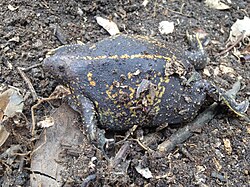Biology:Pipoidea
| Pipoidea | |
|---|---|

| |
| Pipa pipa, the common Suriname toad (Pipidae) | |

| |
| The Mexican burrowing toad Rhinophrynus dorsalis (Rhinophrynidae) | |
| Scientific classification | |
| Domain: | Eukaryota |
| Kingdom: | Animalia |
| Phylum: | Chordata |
| Class: | Amphibia |
| Order: | Anura |
| Clade: | Pipoidea Laurent in Fuhn, 1960 |
| Subgroups[2] | |
|
See text | |
Pipoidea are a clade of frogs, that contains the most recent common ancestor of living Pipidae and Rhinophrynidae as well as all its descendants.[2] It is broadly equivalent to Xenoanura.
Description
The synapomorphies that define Pipoidea are the absence of mentomeckelian bones, absence of lateral alae of the parasphenoid, fusion of the frontoparietals into an azygous element, greatly enlarged otic capsules, and a tadpole with paired spiracles and which lacks beaks and denticles.[2][3] Later genetic work has supported Pipoidea as a monophyletic group.[4]
Taxonomy
In 1993 Pipoidea was defined by Ford and Cannatella as a node-based taxon.[2] It has variously been defined as a suborder (original definition),[5] superfamily,[1] or an unranked clade.[2] There is no single, authoritative higher-level classification of frogs, and Vitt and Caldwell (2014) use name Xenoanura for a similar clade, skipping Pipoidea altogether,[6] as did Frost et al. (2006).[4]
The oldest record of the group is Rhadinosteus from the Late Jurassic of North America, which is more closely related to Rhinophrynidae than to Pipidae.[7] The oldest records of Pipimorpha (which contains all pipoids more closely related to Pipidae than to Rhinophrynidae) are Neusibatrachus and Gracilibatrachus from the Early Cretaceous of Spain,[8] with other records of the group known from Afro-Arabia and South America like modern Pipidae.[9] The extinct pipimorph family Palaeobatrachidae, particularly the genus Palaeobatrachus were widespread and abundant in Europe during the Cenozoic, until their extinction during the Middle Pleistocene around 500,000 years ago due to being unable to cope with the increasing aridity and freezing temperatures of the ice ages.[10]
Taxonomy after A. M. Aranciaga Rolando et al. 2019[9]
- Rhinophrynidae Late Jurassic-Present
- Pipimorpha Ford and Cannatella, 1993
- †Neusibatrachus Seiffert 1972 La Pedrera de Rúbies Formation, Spain, Early Cretaceous (Barremian)
- †Gracilibatrachus Baez 2013 Las Hoyas, Spain, Early Cretaceous (Barremian)
- †Nevobatrachus Mahony, 2019 (=Cordicephalus Nevo, 1968) Hatira Formation, Israel, Lower Cretaceous
- †Thoraciliacus Nevo 1968 Hatira Formation, Israel, Lower Cretaceous
- †Avitabatrachus Báez, Trueb & Calvo, 2000 Candeleros Formation, Late Cretaceous (Cenomanian)
- †Vulcanobatrachus Trueb et al. 2005 South Africa, Late Cretaceous
- †Cratopipa Carvalho et al., 2019 Crato Formation, Brazil, Early Cretaceous (Aptian)[11]
- †Palaeobatrachidae Europe, Late Cretaceous-Middle Pleistocene
- †Palaeobatrachus Tschudi, 1838 (13+ species) Europe, Middle Eocene-Middle Pleistocene
- †Albionbatrachus Meszoely, Špinar et Ford, 1984 (2 species) Europe, Eocene-Miocene
- Clade Panpipidae Aranciaga Rolando et al. 2019
- †Clade Shelaniinae Aranciaga Rolando et al. 2019
- †Patagopipa Aranciaga Rolando et al. 2019 Huitrera Formation, Argentina, Eocene
- †Kuruleufenia Gómez 2016 Allen Formation, Argentina, Late Cretaceous (Campanian-Maastrichtian)
- †Saltenia Reig 1959 Las Curtiembres Formation, Argentina, Late Cretaceous (Campanian)
- †Shelania Casamiquela 1960 Laguna del Hunco Formation, Argentina, Eocene
- Pipidae Gray 1825 Africa, South America, Late Cretaceous (Cenomanian) - Present
- †Clade Shelaniinae Aranciaga Rolando et al. 2019
References
- ↑ 1.0 1.1 "Superfamily Pipoidea Fitzinger 1843". Paleobiology Database. Fossilworks. http://www.fossilworks.org/cgi-bin/bridge.pl?a=taxonInfo&taxon_no=68504.
- ↑ 2.0 2.1 2.2 2.3 2.4 Ford, Linda S.; Cannatella, David C. (1993). "The major clades of frogs". Herpetological Monographs 7: 94–117. doi:10.2307/1466954.
- ↑ Cannatella, David (11 January 2008). "Anura: Discussion of Phylogenetic Relationships (Pipimorpha)". Tree of Life Project. http://tolweb.org/Anura/16963#DiscussionofPhylogeneticRelationships.
- ↑ 4.0 4.1 Frost, D. R.; Grant, T.; Faivovich, J. N.; Bain, R. H.; Haas, A.; Haddad, C. L. F. B.; De Sá, R. O.; Channing, A. et al. (2006). "The amphibian tree of life". Bulletin of the American Museum of Natural History 297: 1–291. doi:10.1206/0003-0090(2006)297[0001:TATOL2.0.CO;2].
- ↑ Frost, Darrel R. (2020). "Anura". Amphibian Species of the World: An Online Reference. Version 6.1. American Museum of Natural History. doi:10.5531/db.vz.0001. https://amphibiansoftheworld.amnh.org/Amphibia/Anura.
- ↑ Vitt, Laurie J.; Caldwell, Janalee P. (2014). Herpetology: An Introductory Biology of Amphibians and Reptiles (4th ed.). Academic Press. pp. 92–95.
- ↑ Blackburn, David C.; Roberts, Lauren; Vallejo-Pareja, María C.; Stanley, Edward L. (2019-12-05). "First Record of the Anuran Family Rhinophrynidae from the Oligocene of Eastern North America". Journal of Herpetology 53 (4): 316. doi:10.1670/19-044. ISSN 0022-1511.
- ↑ Gómez, Raúl O.; Lires, Andres I. (October 2019). "High ecomorphological diversity among Early Cretaceous frogs from a large subtropical wetland of Iberia" (in en). Comptes Rendus Palevol 18 (7): 711–723. doi:10.1016/j.crpv.2019.07.005.
- ↑ 9.0 9.1 Rolando, Alexis M. Aranciaga; Agnolin, Federico L.; Corsolini, Julián (October 2019). "A new pipoid frog (Anura, Pipimorpha) from the Paleogene of Patagonia. Paleobiogeographical implications" (in en). Comptes Rendus Palevol 18 (7): 725–734. doi:10.1016/j.crpv.2019.04.003.
- ↑ Wuttke, Michael; Přikryl, Tomáš; Ratnikov, Viacheslav Yu.; Dvořák, Zdeněk; Roček, Zbyněk (September 2012). "Generic diversity and distributional dynamics of the Palaeobatrachidae (Amphibia: Anura)" (in en). Palaeobiodiversity and Palaeoenvironments 92 (3): 367–395. doi:10.1007/s12549-012-0071-y. ISSN 1867-1594. http://link.springer.com/10.1007/s12549-012-0071-y.
- ↑ Báez, Ana M.; Muzzopappa, Paula; Moura, Geraldo J. Barbosa de (May 2021). "The earliest records of pipimorph frogs from South America (Aptian, Crato Formaton, Brazil): A critical evaluation" (in en). Cretaceous Research 121: 104728. doi:10.1016/j.cretres.2020.104728. https://linkinghub.elsevier.com/retrieve/pii/S0195667120304158.
Wikidata ☰ Q16935324 entry
 |

